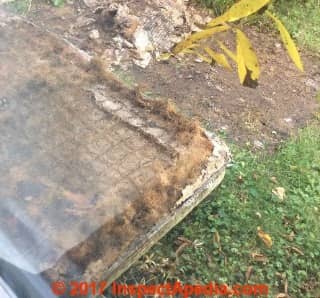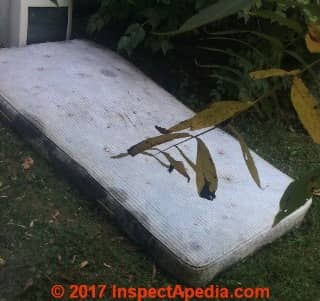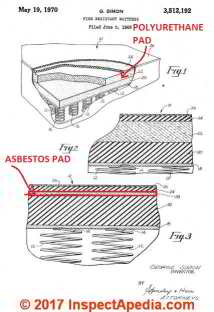 Asbestos in Mattresses
Asbestos in Mattresses
Asbestos fabric or felt in fire-resistant or heated mattresses
- POST a QUESTION or COMMENT about mattresses produced using asbestos materials
Asbestos use in mattresses:
This article describes the use of asbestos felts and fabrics in mattresses produced and used in North America and other areas from about 1921 to the late 1970's.
This article series provides a master list of the forms in which asbestos was used, a list of known asbestos-containing materials, and links to detailed articles about individual asbestos-containing products & materials found in buildings and in a wide range of products used in both home and industry.
InspectAPedia tolerates no conflicts of interest. We have no relationship with advertisers, products, or services discussed at this website.
- Daniel Friedman, Publisher/Editor/Author - See WHO ARE WE?
Asbestos-containing mattresses - Asbestos Fabric or Filling for Mattress Insulation?
Photo: an old mattress, damaged, shedding material, outdoors to be discarded.
[Click to enlarge any image]
Question: does this old mattress from the 1950's or 1960's contain asbestos?
2017/09/09 Anonymous asked:
Is a type of use for asbestos in mattresses? I found a patent for fireproofing mattresses that was unlike what may have been used here in the cotton batting.
The mattress is from the 50s or 60s and has only this batting under the fabric cover and above the mossy stuff.
Might it contain asbestos fibers, or was asbestos used mainly in stuffed ticks and as a pad inside the polyurethane models?
I was surprised to see that there was so little involved in the mattress. Just a thin cottonlike outer fabric, then the batting (which I hope is not containing asbestos) and then the brown stuff and springs.
Here's the appearance of the outside if it helps.
It's got plastic handles and vents on the sides. I think it might be a Sealy brand. T - private email to editor
Reply: the mattress shown above and just below probably does not contain asbestos but some mattresses did indeed use that material
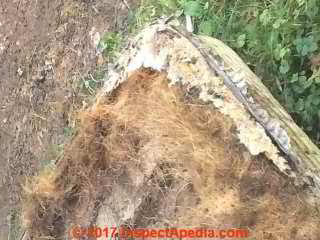 I appreciate both the question and the photo.
I appreciate both the question and the photo.
The brown fibrous material in your photo does not look like and is very unlikely to be asbestos. That material looks like a natural fiber, probably hemp or Jute.
However and perhaps not entirely incidentally, some jute was contaminated with asbestos but typically only where jute bags were used to transport asbestos itself, as we explain
at ASBESTOS CLOTH.
Asbestos was however used in some fire-resistant mattress products and also in some heated mattresses, as well as in special electrically-heated mattresses intended for medical applications.
The use of asbestos felts and fabrics is described in patents as well as in asbestos exposure research on the asbestos exposure of workers in asbestos-using mattress shops.
Wild (1921) described a fire resistant mattress design that might combine polyurethane foam, fiberglass, and asbestos fabric. And below we illustrate an asbestos-pad used in the Simon George patent from 1968, granted 1970.
Some heat-tolerant mattress designs used asbestos both for fire resistance and as a means of directing heat to a desired location, such as Clark's patents (1945, 1946) for an electrically-heated mattress intended to treat the human body.
If asbestos was used in a sleeping mattress it'd be in fabric form, not stuffing.
None of the patents I reviewed used loose-fill asbestos in their designs, all used asbestos fabric or an asbestos-felt-like product, and in all cases the asbestos was not the topmost layer of the mattress.
However if a mattress is falling apart, such as the mattress in your photographs, indeed IF an asbestos fabric or felt had been present it might be deteriorated, friable, and exposed.
You might be able to spot such an asbestos-containing mattress by observing
- Multiple layers of fabric and foam rather than the more simple mattress that appears in your photos: cotton fabric over a filling.
- Presence of electric heating elements (in some mattress designs).
Patent & Health Research on Use of Asbestos in Mattresses
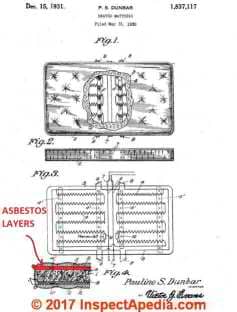
- ASBESTOS TEXTILES - web article describes a wide range of cloth products that used asbestos.
- Clark, W. F. (1946). U.S. Patent No. RE22,763. Washington, DC: U.S. Patent and Trademark Office.
- Clark, Warren F. "Mattress for treating human body ailments by heat therapy." U.S. Patent 2,376,902, issued May 29, 1945.
Used an asbestos sheet - Dunbar, Pauline S. "Heated mattress." U.S. Patent 1,837,117, issued December 15, 1931. [Illustrated above/left] [Click to enlarge any image]
Excerpts:
The device of the present invention is adapted for-embodiment in any mattress of the ordinary type including the usual filling which is indicated in the drawings by the numeral lA and the usual covering indicated by the numeral 2.
Arranged between the filling and covering are two layers indicated by the numeral 3, one of the layers of asbestos or other insulating material, the other layer of felt or other material to hold heat and distribute it uniformly to the surface of the mattress, and the electrical resistance heating unit of the invention is arranged between these layers.
...
A mattress comprising filling material, an asbestos sheet bearing against said material, an electrical resistance heatingunt in the form of a manifold laid upon the asbestos sheet, a thermostat included in said unit, a sheet of felt laid upon said unit, straps located between said sheets and attached thereto at points between the folds of the heating unit and disposed transversely across said folds and a covering enclosing said assemblage.
... the coils which comprise the units l, are so housed within the mattress as not to in any way come in contact with either the filling or the covering of the mattress, and inasmuch as the bottom one of the layers 5 is of asbestos, the top layer is of felt or other material to hold heat and evenly distribute 'and transfer it to the surface of the mattress.
- Harries, P. G. "Asbestos dust concentrations in ship repairing: a practical approach to improving asbestos hygiene in naval dockyards." Annals of Occupational Hygiene 14, no. 3 (1971): 241-254.
Excerpt:
Asbestos mattress shop A new purpose built mattress shop was erected during the course of the survey and the results in Table 8 show that there is little difference between it and the old shop. The high counts in each shop - Harries, P. G. "Asbestos hazards in naval dockyards." Annals of occupational hygiene 11, no. 2 (1968): 135-145.
Abstract
A brief description is given of the types of asbestos materials, and their uses in shipbuilding and ship repairing in Naval Dockyards. An outline of the problems to be faced and a description of preventive methods is followed by a series of questions intended to stimulate practical solutions to the problems of using asbestos materials safely in the industry.
Excerpt: Less than 450 men are classed as asbestos workers and only the 50 men who work in the asbestos mattress shops are subject to the Asbestos Industry Regulations.
- George, Simon. "Fire resistant mattress." U.S. Patent 3,512,192, issued May 19, 1970. Illustration shown above indicates the position of an asbestos pad in the George patent.
Abstract excerpts:
A mattress constructed so as to render it resistant to ignition by a glowing source as well as ignition by a flaming source. ... By utilizing a multilayer structure (see FIG. 1) comprising layers of polyurethane foam (preferably per specification of ASTM D-1564-62T) along with a heat "ice resistant layer of Fiberglas or asbestos and a chemically threated ticking;
a mattress is obtained which exhibits excellent resistance to fires as well as the comfort features desired.
FIG. 3 illustrates another embodiment of the invention which is essentially the same as that of FIG. 1 except that the Fiberglas layer 22 has been replaced by an asbestos pad 28. The pad 28 has a thickness in the order of /s inch and weighs about ounces per square yard.
The thickness for the polyurethane layer is preferably in the order of 1 /2 inches thick. The asbestos pad 28 performs the same functions previously described for Fiberglas layer 22, namely a heat shield.
The Fiberglass, however, also serves as a filler and provides an air chamber since it has more thickness and a lower density. It is believed that the air chamber in the Fiberglas matting 22 provides some additional insulation and tends to resist heat somewhat better than the asbestos pad 28, however, the asbestos pad has performed quite successfully and may be used in place of the Fiberglas layer 22 if desired. - U.S EPA, LIST OF USES COVERED UNDER APRIL 2019 FINAL RULE; RESTRICTIONS ON DISCONTINUED USES OF ASBESTOS [PDF] (2019), U.S. Environmental Protection Agency, original source: https://www.epa.gov/asbestos/list-uses-covered-under-april-2019-final-rule-restrictions-discontinued-uses-asbestos
Under the April 2019 Final Rule:
The public is protected from uses of asbestos that are no longer on the market and are not covered under any other laws or regulations.
Products like certain asbestos vinyl floor tiles, insulation, and other building materials, as well as clothing and manufacturing products, are prohibited from being produced and sold before EPA reviews them and puts in place any necessary restrictions or prohibits use.
EPA is not allowing new uses of asbestos. Persons subject to the rule are required to notify EPA at least 90 days before commencing any manufacturing, importing, or processing of asbestos or asbestos-containing products covered under the rule.
These uses are prohibited until EPA conducts a thorough review of the notice and puts in place any necessary restrictions, including prohibiting use.
Uses of asbestos covered under the partial 1989 ban will remain banned. This rule keeps these prohibitions in place and would not amend them in any way. In other words, this action does not provide a means by which these prohibited products could return to the marketplace.
- Wild, R. L. R. "Asbestos mattress covering." Asbestos 3, no. 5 (1921): 2-12.
- ASBESTOS PRODUCTS 1959 - returns to the chapter in ASBESTOS ORIGIN & NATURE where Rosato's Table 1.7 originally appeared.
- Table 1.7. Asbestos Applications - this is a separate PDF file that provides the original Asbestos PPlications Table 1.7 from Rosato (1959) [1] from which the web article above was adapted.
- "16 CFR Chapter 11, Consumer Products Containing Asbestos, Advance Notice of Proposed Rulemaking", [PDF] U.S. Consumer Products Safety Commission, CPSC, U.S. Federal Register, Vol. 44. No 201, 17 October 1979, Proposed Rules, 60057. This document cites a long list of consumer products that contained asbestos.
- Asbestos in medical applications is discussed at ASBESTOS OTHER PRODUCTS
...
Continue reading at ASBESTOS LIST of PRODUCTS - topic home, or select a topic from the closely-related articles below, or see the complete ARTICLE INDEX.
Or see
Recommended Articles
- ASBESTOS LIST of PRODUCTS
- ASBESTOS IDENTIFICATION IN BUILDINGS
- ASBESTOS PHOTO GUIDE to MATERIALS
- ASBESTOS PRODUCTS BANNED vs PERMITTED U.S. 2023
- ASBESTOS TEXTILES
- DOES THIS MATERIAL CONTAIN ASBESTOS? - 5 easy questions to tell if a BUILDING MATERIAL probably contains asbestos -
- HAZARD vs RISK - what's the difference, why you should care
Suggested citation for this web page
ASBESTOS in MATTRESSES at InspectApedia.com - online encyclopedia of building & environmental inspection, testing, diagnosis, repair, & problem prevention advice.
Or see this
INDEX to RELATED ARTICLES: ARTICLE INDEX to ASBESTOS HAZARDS
Or use the SEARCH BOX found below to Ask a Question or Search InspectApedia
Ask a Question or Search InspectApedia
Questions & answers or comments about what building products and common in-building products, appliances, mechanical components were produced using asbestos materials.
Try the search box just below, or if you prefer, post a question or comment in the Comments box below and we will respond promptly.
Search the InspectApedia website
Note: appearance of your Comment below may be delayed: if your comment contains an image, photograph, web link, or text that looks to the software as if it might be a web link, your posting will appear after it has been approved by a moderator. Apologies for the delay.
Only one image can be added per comment but you can post as many comments, and therefore images, as you like.
You will not receive a notification when a response to your question has been posted.
Please bookmark this page to make it easy for you to check back for our response.
IF above you see "Comment Form is loading comments..." then COMMENT BOX - countable.ca / bawkbox.com IS NOT WORKING.
In any case you are welcome to send an email directly to us at InspectApedia.com at editor@inspectApedia.com
We'll reply to you directly. Please help us help you by noting, in your email, the URL of the InspectApedia page where you wanted to comment.
Citations & References
In addition to any citations in the article above, a full list is available on request.
- "16 CFR Chapter 11, Consumer Products Containin Asbestos, Advance Notice of Proposed Rulemaking", [PDF] U.S. Consumer Products Safety Commission, CPSC, U.S. Federal Register, Vol. 44. No 201, 17 October 1979, Proposed Rules, 60057. This document cites a long list of consumer products that contained asbestos.
- Archer, S. R., and T. R. Blackwood. Status assessment of toxic chemicals: asbestos. Vol. 1. Environmental Protection Agency, Office of Research and Development, Industrial Environmental Research Laboratory, 1979. In this text, table 4. U.S. Asbestos Uses (3)
This book is available as a free e-book via Google Play. Link:
https://play.google.com/books/reader?id=U57ObCey-wcC&printsec=frontcover&output=reader&hl=en&pg=GBS.PP1 - ASBESTOS HISTORY & PROPERTIES [Book online] D.V. Roasato, engineering consultant, Newton MA, Reinhold Publishing Co., NY, 1959, Library of Congress Catalog No. 59-12535. We have re-published this text as an online book at InspectApedia. Excerpts & adaptations are also found in InspectApedia.com articles on asbestos history, production & visual identification in and on buildings.
- "Asbestos in Plastic Compositions", A.B. Cummins, Modern Plastics [un-dated, pre 1952]
- "Asbestos in Your Home," Spokane County Air Pollution Control Authority, Spokane WA 509-477-4727 www.scapa.org provides a one-page image, a .pdf file drawing of a house warning of some possible sources of asbestos in the home. The sources are not ranked according to actual risk of releasing hazardous levels of airborne asbestos fibers and the list is useful but incomplete.
- Chrysotile [asbestos] and Its Uses, Louis Perron, Minerals and Metals Sector, Canadian Minerals Yearbook, 2002, Natural Resources Canada, web search 03/01/2011, original source: http://www.nrcan-rncan.gc.ca/mms-smm/busi-indu/cmy-amc/content/2002/20.pdf
- The US EPA provides a sample list of asbestos containing products epa.gov/earth1r6/6pd/asbestos/asbmatl.htm
- ASBESTOS IN YOUR HOME U.S. EPA, Exposure Evaluation Division, Office of Toxic Substances, Office of Pesticides and Toxic Substances, U.S. Environmental Protection Agency, Washington,D.C. 20460
- Asbestos products and their history and use in various building materials such as asphalt and vinyl flooring includes discussion which draws on ASBESTOS, ITS INDUSTRIAL APPLICATIONS, ROSATO 1959, D.V. Rosato, engineering consultant, Newton, MA, Reinhold Publishing, 1959 Library of Congress Catalog Card No.: 59-12535 (out of print, text and images available at InspectAPedia.com).
- EPA ASBESTOS MATERIALS BAN: CLARIFICATION 1999
- "Handling Asbestos-Containing roofing material - an update", Carl Good, NRCA Associate Executive Director, Professional Roofing, February 1992, p. 38-43
- EPA Guidance for Controlling Asbestos-Containing Materials in buildings, NIAST, National Institute on Abatement Sciences & Technology, [republishing EPA public documents] 1985 ed., Exposure Evaluation Division, Office of Toxic Substances, Office of Pesticides and Toxic Substances, U.S. Environmental Protection Agency, Washington,D.C. 20460
CONTINUE READING or RECOMMENDED ARTICLES.
- Carson, Dunlop & Associates Ltd., 120 Carlton Street Suite 407, Toronto ON M5A 4K2. Tel: (416) 964-9415 1-800-268-7070 Email: info@carsondunlop.com. Alan Carson is a past president of ASHI, the American Society of Home Inspectors.
Thanks to Alan Carson and Bob Dunlop, for permission for InspectAPedia to use text excerpts from The HOME REFERENCE BOOK - the Encyclopedia of Homes and to use illustrations from The ILLUSTRATED HOME .
Carson Dunlop Associates provides extensive home inspection education and report writing material. In gratitude we provide links to tsome Carson Dunlop Associates products and services.


